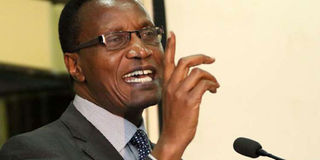Kenya has enough teachers, says study

Education Cabinet Secretary Jacob Kaimenyi speaks during the launch of 2014 Basic Education Statistical Booklet at the Kenyatta International Convention Centre on October 6, 2015. PHOTO | JEFF ANGOTE | NATION MEDIA GROUP
What you need to know:
- The study reveals there are 201,622 teachers employed by the Teachers Service Commission (TSC) in primary schools, while 40,449 are employed by school boards of management, bringing the total to 242,071.
- Kakamega County has the highest number of teachers employed by the TSC at 10,150, with a student population of 557,107 in primary schools, while Lamu has 27,416 pupils in primary schools, with 827 teachers.
- Prof Kaimenyi noted that attempts to develop a system that can deliver timely and reliable education data to aid planning and management of the sector had been unsuccessful.
Kenya has enough teachers to handle early childhood, primary and secondary schools, a government report says.
The 2014 Basic Education Statistical Booklet says the ratio of government-employed teachers to students is within an acceptable range.
According to the study, the problem lies in the distribution of the available teachers across the country.
But unions have always insisted that there is a shortage of about 80,000 teachers.
“There are serious cross-county disparities, ranging from a very high pupil-teacher ratio of 101:3 in Turkana to a low of 25:4 in Baringo,” states the study, which Education Cabinet Secretary Jacob Kaimenyi released in Nairobi yesterday.
The highest student-teacher ratio at the secondary school level is 41:9, in Migori, while the lowest is 17:5 in Samburu. The Pupil Teacher Ratio (PTR) for public schools based on TSC records is 41:5, which compares well with the international ratio of 40.
“Considering the teachers employed by the Boards of Management (BoM), the PTR in public schools drops to 34:5,” the study adds.
Twenty-seven counties lie below the national average, while 20 are above.
ENROLMENT RISING
The study reveals there are 201,622 teachers employed by the Teachers Service Commission (TSC) in primary schools, while 40,449 are employed by school boards of management, bringing the total to 242, 071.
Kakamega County has the highest number of teachers employed by the TSC at 10,150, with a student population of 557,107 in primary schools, while Lamu has 27,416 pupils in primary schools, with 827 teachers.
Turkana has 1,579 TSC teachers with 205,582 pupils in primary schools, and the secondary school enrolment stands at 14,097.
Kakamega has the highest number of students in secondary school at 116,366, while Isiolo has 4,474.
Enrolment in primary education increased from 5.9 million in 2002 to 9.95 million in 2014, thanks to the free primary education programme. Secondary school enrolment went up from 851.800 in 2002 to 2.33 million in 2014.
There is a total of 118,608 teachers in secondary schools, of whom 90.8 per cent are in public schools, while the rest are in private schools. Of all the teachers in public secondary schools, some 33 per cent are employees of school boards.
Prof Kaimenyi noted that attempts to develop a system that can deliver timely and reliable education data to aid planning and management of the sector had been unsuccessful.




